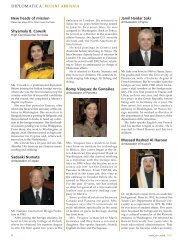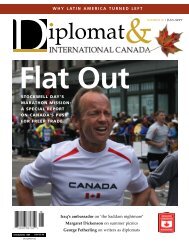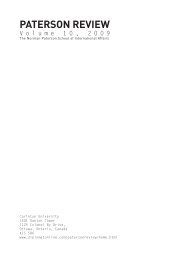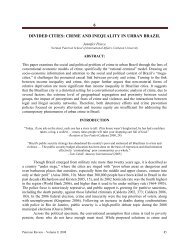the new petro power paradigm - Diplomat Magazine
the new petro power paradigm - Diplomat Magazine
the new petro power paradigm - Diplomat Magazine
You also want an ePaper? Increase the reach of your titles
YUMPU automatically turns print PDFs into web optimized ePapers that Google loves.
DELIGHTS|BOOKS<br />
Jakub Hałun<br />
The Chinese — <strong>the</strong> world’s master wall-builders who erected <strong>the</strong> Great Wall of China, pictured above, to protect <strong>the</strong> nor<strong>the</strong>rn borders of <strong>the</strong><br />
Chinese Empire — have erected a retaliatory wall to keep out North Korean refugees.<br />
• India tries to wall out Pakistan, Bangladesh<br />
and Burma while walling in <strong>the</strong> part<br />
of Kashmir that is in dispute. The lastnamed<br />
wall consists of a long minefield<br />
inside parallel barricades of barbed wire<br />
and concertina wire. (I never realized,<br />
until I heard Lloyd Axworthy speak on <strong>the</strong><br />
subject, that landmines are, of course, far<br />
cheaper than security personnel and so are<br />
often used as unmanned alarm systems in<br />
certain areas of operation.)<br />
• Uzbekistan fenced out Kyrgyzstan in<br />
1999 and Afghanistan two years later. Two<br />
years after that, Botswana walled out Zimbabwe,<br />
first claiming it did so in order to<br />
protect <strong>the</strong> health of livestock.<br />
• The European Union builds walls round<br />
Spanish communities in Morocco as <strong>the</strong><br />
Moroccans erect ones of <strong>the</strong>ir own to secure<br />
resources in Western Sahara.<br />
• There are retaliatory walls, such as one<br />
that <strong>the</strong> Chinese (after all, <strong>the</strong> world’s<br />
master wall-builders) erected to keep out<br />
North Korean refugees. This caused people<br />
on <strong>the</strong> o<strong>the</strong>r side to put up <strong>the</strong>ir own<br />
wall, to keep at bay those hordes of nonexistent<br />
Chinese refugees eager to live in<br />
luxury in North Korea. Then <strong>the</strong>re are cooperative<br />
walls. Malaysia, worried about<br />
Muslim guerrillas in <strong>the</strong> north, worked<br />
on a system of steel-and-concrete barriers<br />
in partnership with Thailand, which is<br />
58<br />
alarmed periodically by <strong>the</strong> same violent<br />
extremists in its own three sou<strong>the</strong>rn-most<br />
provinces. Looking ahead, <strong>the</strong> United<br />
Arab Emirates plans a wall to protect its<br />
border with Oman.<br />
With so much wall-building going<br />
on, could we be headed for a wall gap,<br />
analogous to <strong>the</strong> missile gap of which<br />
defence analysts and pundits spoke so<br />
often during <strong>the</strong> Cold War? To Dr. Brown,<br />
who teaches at <strong>the</strong> University of California<br />
in Berkeley, <strong>the</strong> answer would doubtless<br />
be no. To her way of thinking, protective<br />
walls, though as old as civilization itself,<br />
covering everything from “little more than<br />
crude fences [that ran] through fields [to]<br />
mammoth imposing structures heavily<br />
armed with contemporary surveillance<br />
technology,” are constantly changing.<br />
The greatest changes have been <strong>the</strong> most<br />
recent.<br />
The medieval fortifications that punctuate<br />
<strong>the</strong> European landscape were built<br />
not only to deter invaders. They also were<br />
made to shock and awe (as well as comfort)<br />
those living inside. The architectural<br />
gigantism <strong>the</strong>y saw every day made docile<br />
taxpayers of poor souls living in tiny<br />
dwellings in sight of <strong>the</strong> gates. In <strong>the</strong> same<br />
way, stained glass windows in ca<strong>the</strong>drals<br />
made devout worshippers of <strong>the</strong>se same<br />
people, who o<strong>the</strong>rwise rarely saw bright<br />
colours except in nature. In early modern<br />
Europe, city walls were built up and repaired<br />
over generations as part of every<br />
citizen’s duty. Such practices encouraged<br />
<strong>the</strong> rise of city-states, such as those in Italy<br />
during <strong>the</strong> Renaissance. In turn, competition<br />
among city-states brought nationstates<br />
into being. Such nation-states,<br />
intertwined with <strong>the</strong> idea of sovereignty,<br />
lie at <strong>the</strong> heart of this book.<br />
Walled living (<strong>the</strong> phrase sounds as<br />
though it belongs in a prospectus for a<br />
<strong>new</strong> condo development) ensured everyone<br />
a place to hide when jealous rivals and<br />
wacky potentates attacked communities<br />
for <strong>the</strong>ir belief-systems or <strong>the</strong>ir wealth.<br />
Now, with <strong>the</strong> global economy playing<br />
havoc with nation-state sovereignty, or at<br />
least making separate concepts of what<br />
used to be only one, Dr. Brown sees all<br />
<strong>the</strong>se <strong>new</strong> wall megaprojects not as “resurgent<br />
expressions of nation-state sovereignty<br />
[but as] icons of its erosion.”<br />
Her view is that “far from defenses<br />
against international invasions by o<strong>the</strong>r<br />
state <strong>power</strong>s, 21st-Century walls are<br />
responses to transnational economic, social,<br />
and religious flows that do not have<br />
<strong>the</strong> force of political sovereignty behind<br />
<strong>the</strong>m.”<br />
Thus, she continues, <strong>the</strong>re is a strange<br />
unspoken dialogue between “neoliberals,<br />
FALL 2011 | OCT-NOV-DEC

















